The Tell Aphek Khopesh
Home > The Sword collection >Tell Aphek
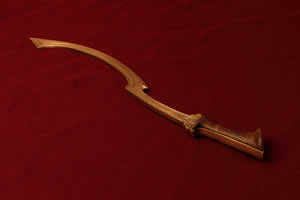 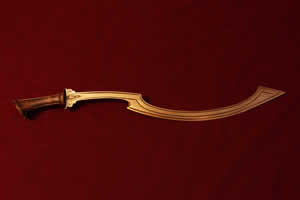 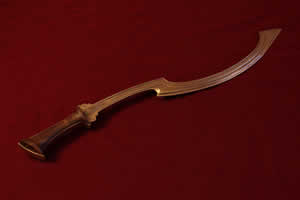 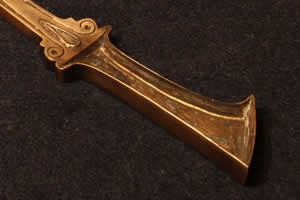 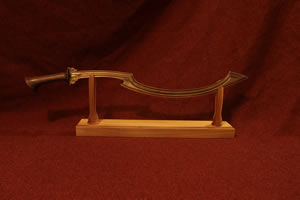
Replica of the khopesh from Tell AphekWeight: c.980 grams - Length: 60,5 cm - Material: bronze (Cu90Sn10, same as the original), walnut Edge: hardened through cold hammering, ground - Original: Sword from Tell Aphek (Kurdani), S. Shalev nr. 170.
|
||
|---|---|---|
The KhopeshThe khopesh, also known as the sickle-sword, is a curved, single edged sword from the Near East, mainly Egypt and Canaan. The Egyptian term "khepesh", hinted at the resemblance to the foreleg of a cow or an ox, as well as it was its owner's "mighty arm". The khopesh first appeared in the Middle Bronze Age, in the centuries before 2000 B.C., and went out of use after 1200 B.C. For the Middle Bronze Age specimens, the typology established by H.W. Müller (1986) seems still sound (groups I, II and III).
These early blades had a tang for hilt, and a back-turned tip, sometimes turned into a full curl (Müller's group I).
From Byblos comes a collection of blades with the same basic design, but decorated through highly complex incrustation of gold, electrum and copper (Müller's group II). These are dated to approximately 1900-1700 B.C.
And then there are a few specimens from the Hyksos period, 1650-1550 B.C (Müller group III). One of these, the sword from "Qantir"East Delta (Munich ÄS 5557), has a flanged hilt in stead of the tang, and reseambles what we might call the khopesh proper of the Late Bronze Age. Typology of Late Bronze Age sickle swords (from Vogel 2006). There are about 20 known sickle swords from the Late Bronze Age (the New Kingdom of Egypt). The majority is from undatable contexts, the exceptions being the two swords from the tomb of Tutankhamun, the sword with an inscription of the name of Ramesses II, and a sword from a burial at Gezer (now kept at Museum der Altorientalischen Kulturen, Istanbul). The rest are dated through resemblance to these specimens. Carola Vogel has brought the most updated overview, as well as a revision of the typology. The most numerous variant D (Shalev's type 8B), with 6 specimens, includes the largest of the two swords from Tutankhamun, the Ramesses II sword, as well as the sword on which the replica is based on (Tell Aphek). This is what we might call the "classic" kopesh.
The Tutankhamun sword is distinguished from the rest by having a somewhat more elaborate "lotus flower" ornament, the coat of arms of Upper Egypt, but in particular by a more complex cross-section of the blade. The swords from Sichem-Samaria (according to Müller, or unknown origin according to Shalev, no. 169) and Tell-Aphek are very similar to each other, and are also close to the Tutankhamun sword. Both have the lotus symbol of Upper Egypt. Possibly should also the sword from Ras Shamra be counted to this sub-variant, but its poor state of preservation makes it impossible to decide whether it originally carried the lotus-ornament or not. The Tutankhamun sword is 59cm long, Sichem-Samaria 65 cm, Ras Shamra 58 cm, and Tell Aphek 60 cm. The Tell Aphek sword was chosen because it seems to be a good representation, medium size, well documented and well preserved, of this sub-group within the "classic" khopeshes.
Who carried and used the khopesh with the lily-flower? Not all foot-soldiers carried swords, so perhaps these were carried by officers or used by special elite troops? A scene from a temple at Deir-el-Bahari, c. 1480 B.C., shows a possible officer with khopesh, spear and shield.
Egyptian soldiers in a scene from a temple at Deir-el-Bahari, c. 1480 B.C.
Soldiers, perhaps an elite corps, with khopeshes, spears, slings and shields. Kairo, c. 1340 B.C. The khopesh was surely used for cutting and slashing in the heat of battle, but it is also likely to have been used in the bloody aftermath of battle. The Egyptians regularly cut of hands and penises of their slayed enemies, in order to summarize a body count. A seal from Minet-el-Beida shows a Syrian warrior with the khopesh in his right hand, and a cut off head of an enemy on a spear, in his left hand.
Litterature:
Müller, H. W. 1987. Der Waffenfund von Balata-Sichem und Die Sichelschwerter. München, Bayerische Akademie der Wissenschaften. Shalev S. 2004. Swords and Daggers in Late Bronze Age Canaan. Prahistorische Bronzefunde IV,13. Stuttgart, Franz Steiner Verlag. Vogel, C. 2006: Hieb- und stichfest? Überlegungen zur Typologie des Sichelschwertes im Neuen Reich. In: D. Bröckelmann and A. Klug (eds.), In Pharaos Staat: Vogel, C. 2013: Icon of Propaganda and Lethal Weapon: Further Remarks on the Late Bronze Age Sickle Sword. In: O'Brian, S. and D. Boatright (eds), Warfare and Society in the Ancient Eastern Mediterranean. Papers arising from a colloquium held at the University of Liverpool, 13th June 2008 (71-87). BAR International Series 2583 2013.
|
||
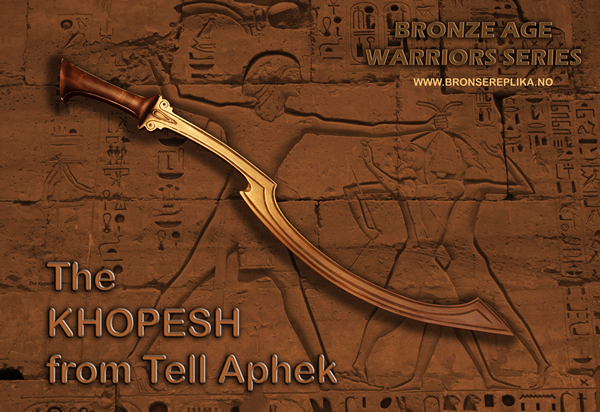
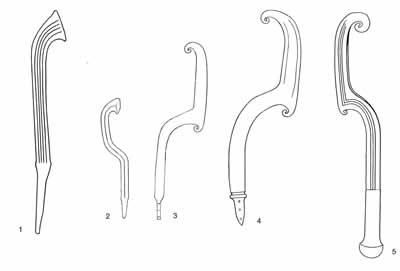 Type I sickle swords (from Müller 1986).
Type I sickle swords (from Müller 1986).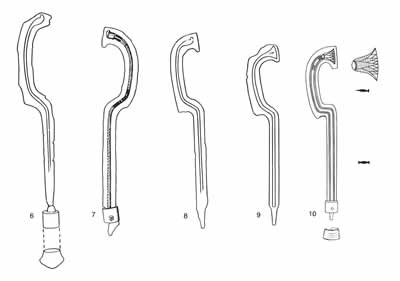 Type II sickle swords (from Müller 1986).
Type II sickle swords (from Müller 1986).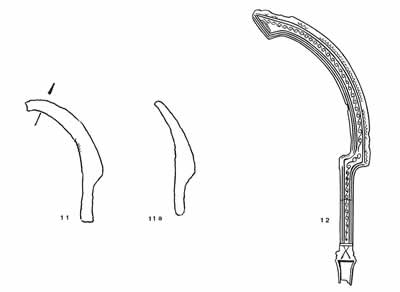 Type III sickle swords (from Müller 1986).
Type III sickle swords (from Müller 1986).
 Khopesh from the tomb of Tutankhamun (from Müller 1986).
Khopesh from the tomb of Tutankhamun (from Müller 1986).  Khopesh from Tell Aphek (from Shalev 2004: no. 170).
Khopesh from Tell Aphek (from Shalev 2004: no. 170).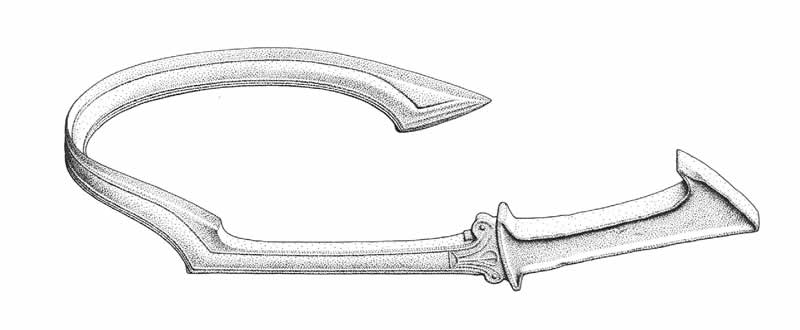 Khopesh with unknown origin (Sichem Samaria?) (from Shalev 2004: no. 169).
Khopesh with unknown origin (Sichem Samaria?) (from Shalev 2004: no. 169). Khopesh from Ras Shamra (from Shalev 2004: no. 171).
Khopesh from Ras Shamra (from Shalev 2004: no. 171).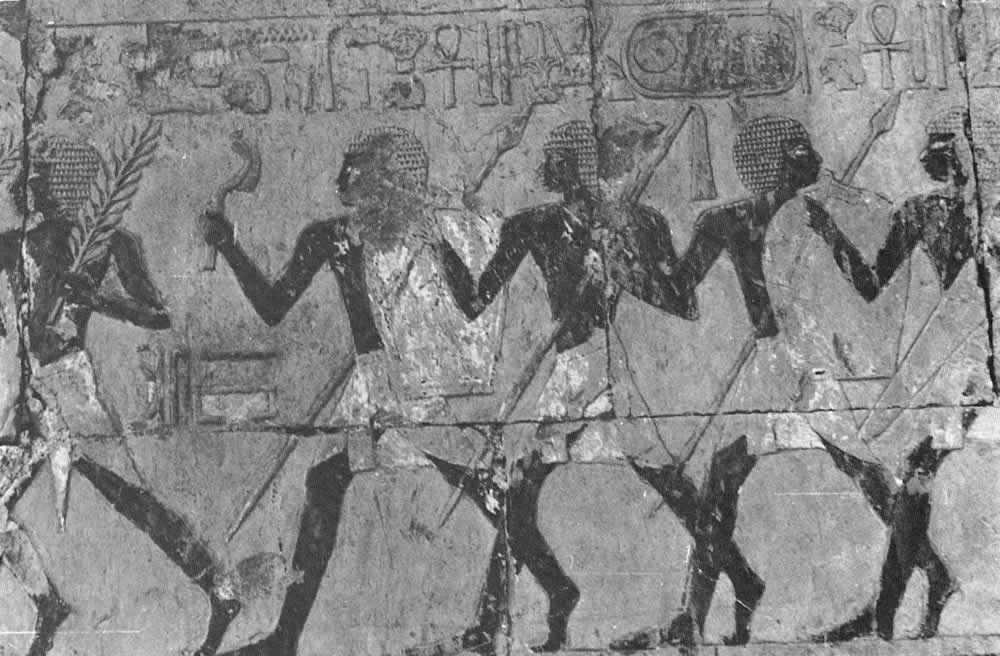
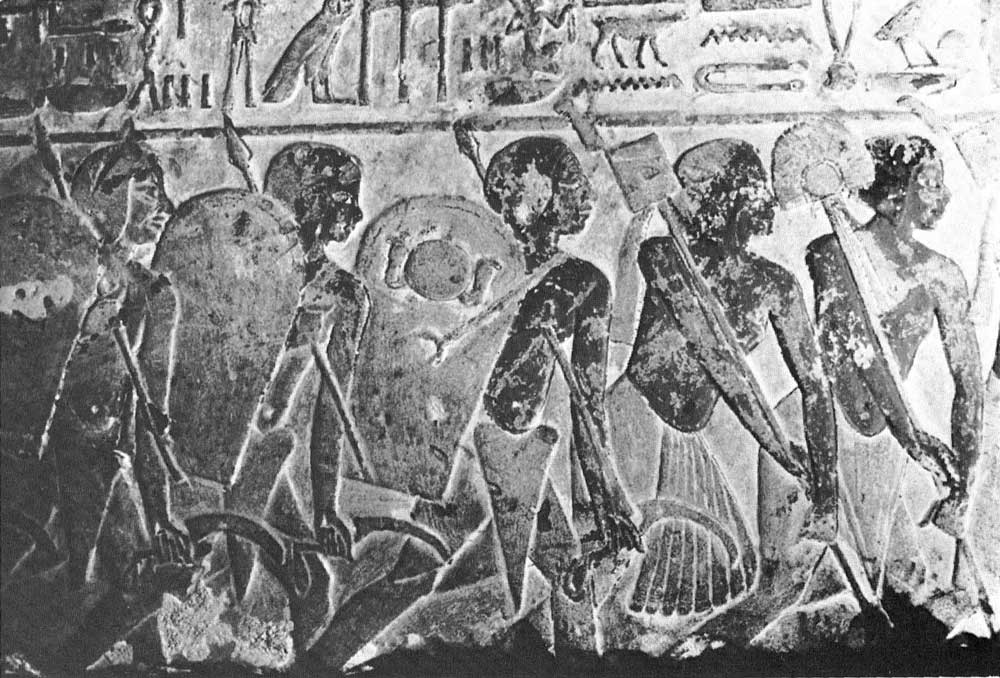
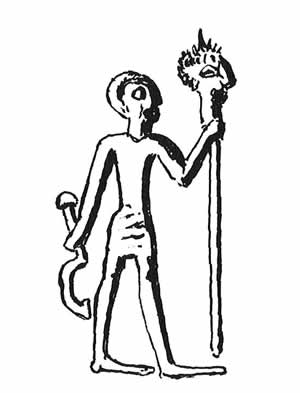 Syrian warrior with sickle sword and head-throphy on a spear, on cylinder seal from Minet-elBeida (from Müller 1986: Abb 48.
Syrian warrior with sickle sword and head-throphy on a spear, on cylinder seal from Minet-elBeida (from Müller 1986: Abb 48.